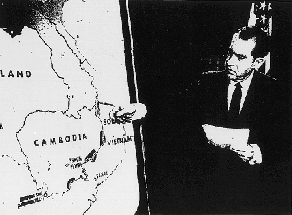On April 30th 1970 President Richard Nixon announced to a national television audience that US troops were invading Cambodia, the country west of Vietnam through which the North Vietnamese military was supplying their troops in the South. In fact, the US had been conducting bombing raids in Cambodia for over a year.
The image of the President's hand resting over an abstract map of Cambodia circulated widely. It appeared not only in the New York Times but on the cover of Time. Millions also saw it on live television as Nixon disclosed the invasion. Several journalistic accounts commented on the sense of disbelief and helplessness felt by many viewers. Time's cover story began,
"At one point during his television address to the nation last week, Richard Nixon lost his place in the typescript. For four or five seconds he shuffled pages, eyes darting through paragraphs to pick up the trail again. For the nation watching, it was an instant of complex psychology. There was the acute embarrassment and sympathy for the speaker who has fluffed his lines. There was also, for some, an eccentric half hope that if he could not continue, an absurdist, McLuhan logic would apply: 'The U.S. was about to move into Cambodia, but the President lost his place in the script.' The instant passed. Richard Nixon went on."
For the past year the Nixon had been promoting the "Vietnamization" of the war, promising to replace US troops with newly-trained South Vietnamese soldiers. Citizens had expressed relief at the thought of American fighters coming home.
On the heels of Presidential promises of de-escalation, the April 30, announcement caused many in the United States to respond with shock and anger. Protests erupted across the country, including one at Kent State University that ended in the fatal shooting of four students by National Guardsmen.

No comments:
Post a Comment